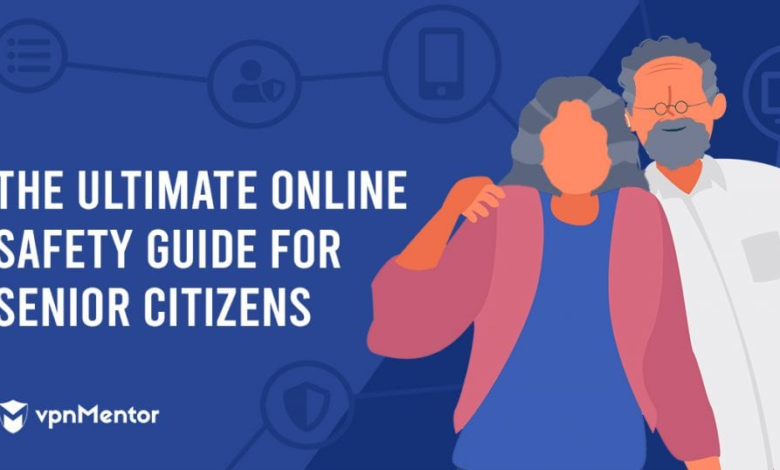Digital Safety for Seniors: Protect Against Scams and Fraud

Digital safety for seniors is an increasingly critical topic as technology evolves at a staggering pace. Older adults often find themselves vulnerable to various online threats, including senior scams that exploit their lack of familiarity with digital landscapes. Protecting seniors online requires a proactive approach to digital literacy for seniors, which enhances their ability to navigate the internet safely. The rise of AI scams targeting seniors presents unique challenges, as these cunning frauds can easily manipulate personal information and create convincing scenarios. To empower our senior population, it’s vital to educate them about online safety for the elderly and provide them with the tools necessary to protect themselves from scams and cyber threats.
As the internet becomes an integral part of everyday life, ensuring the online safety of elderly individuals is of utmost importance. The digital world offers immense opportunities for connection and information, but it also harbors significant risks, particularly for aged adults who may lack the technological savvy needed to identify potential threats. Awareness of digital scams and understanding the nuances of safe online behavior are essential components of navigating today’s tech-driven landscape. With advancements in technology, like artificial intelligence, it’s more important than ever to focus on educating older generations about their digital rights and responsibilities. By fostering a culture of digital wellness, we can better equip seniors to engage confidently in the virtual domain.
Understanding Senior Scams: What Every Elder Needs to Know
As digital technology evolves, older adults are increasingly finding themselves at risk due to a spike in senior scams. According to recent studies, seniors are targeted primarily because they often have fixed incomes and accumulated savings that fraudsters find appealing. Understanding common tactics that scammers use is essential for seniors to protect themselves. For instance, many scams revolve around fake offers or threats, luring seniors into giving out personal information or money they can’t afford to lose.
Moreover, technology that the younger generation takes for granted often operates differently for seniors. With unfamiliarity with digital platforms, older adults may easily fall prey to phishing emails or fake telephone calls. Scammers frequently exploit this gap in knowledge, compounding the issue of digital literacy for seniors and amplifying their vulnerability. Raising awareness about these tactics and encouraging discussions about experiences with potential scams can empower seniors to safeguard their interests more effectively.
Digital Safety for Seniors: Key Strategies for Protection
Digital safety for seniors involves a combination of education, proactive behaviors, and community support. First and foremost, seniors should be taught how to use technology wisely, including setting strong passwords and identifying legitimate websites. Workshops, like those offered by organizations such as OATS, provide critical knowledge on the importance of secure online practices and recognizing signs of fraud. For instance, familiarizing themselves with URLs, safeguarding social media profiles, and maintaining strong, unique passwords can dramatically reduce their susceptibility to online threats.
Additionally, creating a supportive network where seniors can share their concerns about technology plays a pivotal role in their digital safety. Family members can assist by guiding them through complex online tasks and advising them on suspicious practices. Encouraging seniors to discuss their experiences and seek help fosters an environment of vigilance and resilience in the fight against digital scams. When they feel secure and supported, they can enjoy the benefits of technology without unnecessary fear.
Combatting AI Scams: Awareness is Key
AI scams are an emerging threat for seniors. Scammers use AI technology to craft convincing fake voices, making it harder for victims to discern authenticity during phone calls. For instance, a scammer may use AI voice cloning to impersonate a family member in distress, urging the senior to send money immediately. This deceptive strategy relies heavily on manipulation and can leave older adults feeling confused and violated. Awareness of such AI-driven tactics is essential in empowering seniors to reject suspicious requests.
Experts suggest that enhancing digital literacy can significantly combat the ease with which these scams can succeed. By training seniors on how to verify caller identities through alternate means—such as calling the family member directly—they can circumvent the potential trap set by technology. Moreover, encouraging vigilance can dissuade seniors from acting quickly on emotional pleas, advising them that it’s acceptable to take their time to investigate before responding to any high-pressure scenario.
The Importance of Digital Literacy for Seniors
Digital literacy for seniors is more than just knowing how to send an email or browse the web; it encompasses a broad understanding of how to navigate the digital landscape safely. Many elderly individuals grew up in a time when face-to-face interaction was the norm, leading to a steep learning curve when engaging with modern technology. By focusing on improving these skills, seniors can feel more empowered and confident while using the internet, effectively reducing their risk of falling victim to scams.
Community initiatives and training programs tailored specifically for older adults are vital in this digital age. Organizations like OATS are working actively to bridge this gap by providing lessons that teach not only the mechanics of using devices but also the contextual knowledge necessary to avoid scams. These programs emphasize the importance of critical thinking when assessing online content, allowing seniors to develop better judgment and informed decision-making that enhances their overall digital competence.
Protecting Seniors Online: Building Stronger Support Structures
To protect seniors online, it is imperative to construct robust support networks that help elderly individuals navigate the challenges they face in a digital world. Family members, caregivers, and community organizations can play vital roles in enhancing online safety for seniors. Through collaboration, important conversations can take place—sharing knowledge about online dangers, discussing recent scams, and providing a platform for airing concerns about technology use.
Moreover, establishing clear communication lines in families can ensure that seniors know they can seek help without judgment or fear. Regular check-ins and technology use reminders can support seniors while they become accustomed to digital practices. By fostering supportive relationships and encouraging openness about their experiences and challenges, we create an environment that not only protects but encourages seniors to embrace technology confidently.
Realizing the Risks: Scams Targeting Seniors
Every year, millions of seniors fall victim to scams specifically designed with them in mind. Fraudsters often leverage seniors’ emotional connections—whether through calls that mimic the voices of loved ones or invitations to win prizes that feel too enticing to ignore. Understanding the psychology behind these scams can help seniors recognize when something seems off. Being aware of the latest trends in senior scams also informs them about potential new threats, which encourages proactive engagement with technology.
In the face of escalating risks, establishing protective measures becomes critical. Trusted adult children and relatives must play an integral role in educating their elderly family members about current scam tactics. Teaching them to verify information and not to engage immediately, but instead think critically is essential for reducing vulnerability to ongoing scams and fraud. Moreover, engaging seniors in discussions about their digital experiences can help equip them with the knowledge necessary to fend off potential threats.
Utilizing Social Media Responsibly: A Guide for Seniors
The rise of social media has highlighted both its benefits and potential dangers, especially for seniors who may use these platforms to connect with family and friends. While social media can combat feelings of isolation, it also serves as a breeding ground for scammers. Scammers often create fake profiles, targeting seniors with fraudulent friendship requests that can lead to various scams. Educating seniors about the risks associated with social media and how to use these platforms responsibly can make a significant difference.
By guiding seniors on privacy settings, how to identify impostors, and protecting personal information, they can enjoy digital connections without compromising their security. Workshops that simulate social media experiences and highlight red flags can provide essential practice to enhance their confidence in using these networks. When seniors understand how to navigate social media safely, they can leverage it as a tool for connection rather than fear.
Creating a Culture of Vigilance: Engaging Seniors in Online Safety
Establishing a culture of vigilance among seniors regarding online safety is vital. Learning about potential digital risks should not feel isolating but rather a collective effort that involves families and communities working together to empower seniors. Encouraging online safety practices through community workshops, social gatherings, and sharing engaging stories about victims can raise awareness about the dangers of online scams. A community that discusses and handles these issues together reduces the feeling of vulnerability among seniors.
Seniors should be encouraged to speak openly about their online interactions and any concerns they may have. Regular family discussions about digital hygiene can create an environment of shared vigilance, where caution becomes a natural part of their digital lifestyle. With supportive resources and ongoing education, seniors can learn to engage with technology meaningfully while minimizing personal risks.
Seeking Help: Resources Available for Seniors in the Digital Space
In navigating the digital space, many resources exist to guide seniors in protecting themselves against scams and enhancing their digital literacy. Nonprofits and community organizations typically offer workshops and training sessions specifically geared towards older adults, providing them with the skills they need to thrive in a digital world. Seniors can take advantage of these resources to learn everything from basic device usage to identifying scams, ultimately equipping them with the tools necessary to stay safe online.
Additionally, local libraries, community centers, and senior associations often host educational programs and volunteer opportunities for experienced individuals to help educate their peers. These collaborative learning environments are equally beneficial as they promote interaction among seniors. Engaging with others facing similar learning curves helps build camaraderie in the pursuit of digital safety, addressing common fears and misconceptions while empowering seniors to embrace technology.
Frequently Asked Questions
What are some common senior scams related to digital safety for seniors?
Common senior scams that impact digital safety for seniors include phishing emails, fake tech support calls, online dating scams, and AI-driven scams like voice cloning. Seniors should be particularly cautious of any unsolicited communications asking for personal information.
How can seniors improve their online safety and digital literacy for seniors?
Seniors can improve their digital literacy by taking advantage of technology training programs tailored specifically for older adults. Programs like those offered by Older Adults Technology Services (OATS) help seniors learn about online safety, recognizing scams, and using devices securely.
What steps can seniors take to protect themselves online from scams and fraud?
To protect themselves online, seniors should verify the source of emails and calls, avoid clicking on unknown links, regularly update passwords, and use two-factor authentication where possible. Engaging family members for tech support can also enhance their digital safety.
What should seniors know about AI scams targeting seniors?
Seniors should be aware that AI scams, such as voice cloning, can impersonate loved ones seeking money or personal information. It’s crucial for seniors to always verify requests through direct communication with the person in question before taking action.
How can family members assist in protecting seniors online?
Family members can assist by providing guidance on safe internet practices, helping seniors set up privacy settings, and being a resource for any digital questions they may have. Regular discussions about online safety can nurture their awareness.
What digital safety measures can seniors take while using social media?
On social media, seniors should adjust privacy settings to limit who can see their information, avoid accepting friend requests from unknown individuals, and refrain from sharing personal details publicly. They should also be cautious of messages from existing contacts that seem unusual.
Why are seniors particularly vulnerable to online scams?
Seniors are particularly vulnerable to online scams due to factors such as lack of digital literacy, fear of using technology, and increased isolation which can make them more susceptible to scammers. Awareness and education are key to mitigating these risks.
What resources are available for promoting digital wellness among seniors?
Resources promoting digital wellness among seniors include programs from organizations like Older Adults Technology Services (OATS), community workshops, and online tutorials that cover safe internet practices, recognizing scams, and using technology effectively.
What emerging digital threats should seniors be cautious of?
Seniors should be cautious of emerging digital threats such as AI-generated content, deepfakes, and sophisticated phishing schemes that can manipulate emotions or exploit their trust. Staying informed about new scams can help them remain vigilant.
How can seniors balance enjoying the internet while maintaining digital safety?
Seniors can balance internet enjoyment and safety by seeking out reputable training programs, participating in online communities for seniors, and regularly discussing online experiences with family and friends to ensure they feel supported and informed.
| Key Point | Description |
|---|---|
| Vulnerability of Seniors | Older adults are particularly targeted by scams and fraudulent activities online. |
| AI and Scams | AI technology is utilized in scams, including deceptive voice calls and manipulated media. |
| Barriers to Technology Use | Seniors often fear privacy violations, making them hesitant to use the internet. |
| Preventive Measures | Experts recommend password protection, not answering unknown calls, and verifying suspicious messages. |
| Educational Initiatives | Organizations like OATS are providing digital literacy training to older adults. |
Summary
Digital safety for seniors is increasingly vital as older adults navigate the complexities of the online world. As technology continues to evolve, so too do the scams that target this demographic, putting their financial safety at risk. Seniors can empower themselves against these digital threats by embracing tools and education designed to protect their online activities. By fostering a culture of open dialogue about technology among friends and family, seniors can improve their digital literacy, develop better judgment online, and continue to enjoy the benefits of connectivity—all while maintaining a secure digital environment.




